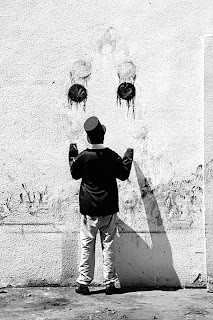Dada South?
Exploring Dada legacies in South African art, 1960 to the present.Curated by Roger van Wyk and Kathryn Smith with Lerato Bereng
Iziko: South African National Gallery
12 December 2009 - 28 Feb 2010

Above: Installation view, courtesy the artists, curators and Iziko National Gallery, Cape Town
This is one of the most fascinating exhibitions we've seen in recent times, even without any special knowledge of the South African contemporary scene. Works by some of the original European Dadaists (Picabia, Duchamp, Ray, Tzara et al) are mingled with a wide array of local artists perceived to have a neo-dadaist connection, covering a period from the 1960s to the present day. Many of these artists are of some renown in their home country, and a number of them (e.g. Jane Alexander, Candice Breitz, William Kentridge, Kendell Geers, Robin Rhode) have significant international reputations, with a few living, working and/or teaching abroad.
There was no catalogue published to coincide with the show, but this may emerge in the future. The independently-curated exhibition is 'an ongoing, participatory project of documentation and research' and more information is available at: http://dadasouth.blogspot.com. To contribute to the Dada South archive of experimental practices, you can email dadasouthza@gmail.com
From the Dada South blog:
It is nearly a century since Dada first touched the central nerve of western culture, attacking its logic, denouncing its ideas of community and nationhood, and demanding total freedom of thought. One of Dada’s primary revolutions is the reinvention of art as a form of tactics. Seen in this way, their work represents the origins of many of the forms we see in contemporary art. In the late 1950s and early 1960s, Dada attitudes found refreshed expression in Neo-Dada movements such as Fluxus, Arte Povera, the Situationist International and Pop Art, which preceded and deeply influenced Minimalism and Conceptual Art. It was in the 1960s that these ideas began to filter into South African art. Dada South? presents a collision of artistic strategies and forms that reflect the impact of Dada; works that are conceived and enacted in the spirit of Dada, which seek to question the conventions, values and function of art in a troubled society. The exhibition surveys an alternative history of resistance in a culture of isolation and repression, one that intersects with the canon of ‘resistance art’, but which deviates into forms that are less didactic, more eclectic and experimental. In the recuperation of these lesser-known histories, Dada South? proposes new vocabularies for South African art.
One of Dada’s lasting legacies is a style of provocation that postures as politics, but in fact ridicules its forms and institutions. Is it not paradoxical then, to host museum exhibitions about a movement that sought to destroy conventions, institutions and value systems? How we can talk about anarchy and the radical when we are bound by conventions of display and the inevitable fetishisation of the art object that the art museum supports?
South African art is often thought to suffer from an ‘anxiety of influence’ from Western artworld centres. Part of this perception is a poor understanding of our own art history. Dada South? intends to invert this by asserting South African practice as part of international art history; acknowledging a range of remarkable artistic positions that have called upon western influences selectively, even randomly, to develop local, indigenous responses to specific conditions of South African history.A major part of this process is about recuperating lost histories, practices and experiments. It is difficult to tell this story, as many works produced in a radical spirit were temporary interventions. They were not necessarily intended as art objects in the traditional sense, and certainly not expected to be purchased by museums for future preservation. As such, many such gestures exist only as oral histories and anecdotes that are occasionally backed up with an ephemeral document, like a poster, photograph, flyer or newspaper article found during an archival hunt.

Above © Robin Rhode Juggla 2007, digital print, courtsey the artist
One has indeed to come to the end of the world, and for me at least to Africa, to find the most ancient, the most archaic things and also – surprisingly though it may seem – the most up-to-date, the most extraordinary things which were dreamt of forty or thirty years ago and are now becoming a reality on this soil of Africa…this new world, which is in a state of ferment…is clearly going to be the world of the future.
- Tristan Tzara, after visiting Zimbabwe and Mozambique, 1962
Interesting? You betcha.



